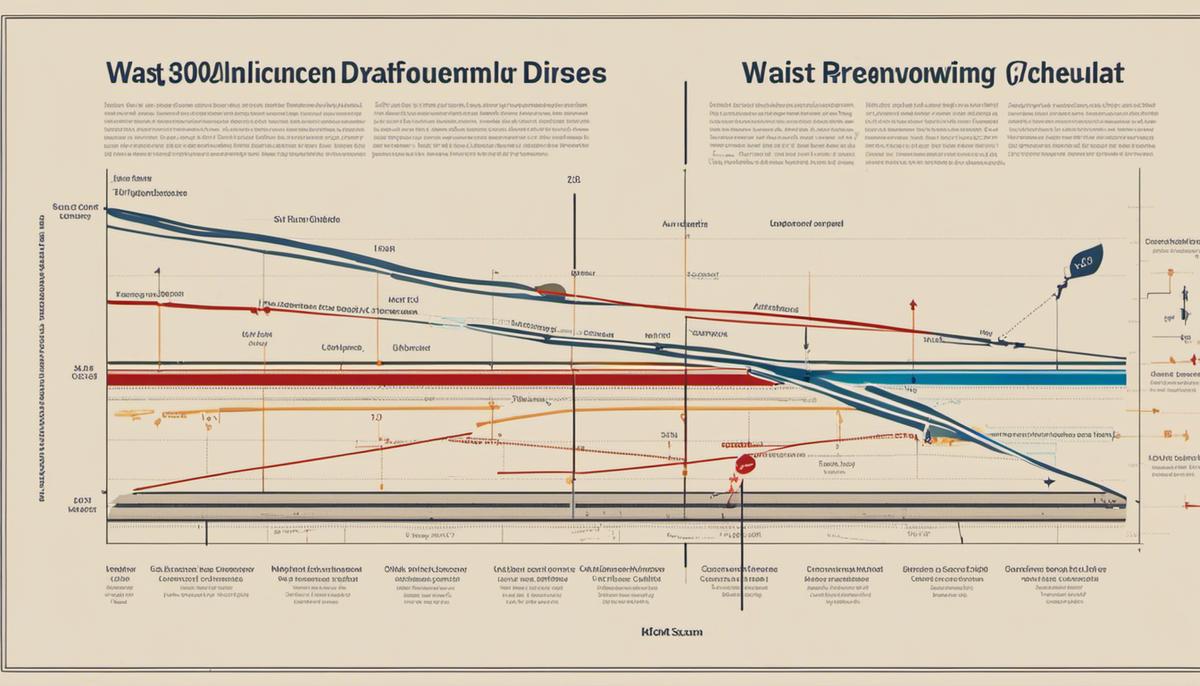The human body is a complex system whose intricate functions and structures are interconnected, and variations in one aspect can pose significant implications on overall health. One such variation, often overlooked, is body girth measurement. Typically, this refers to the circumference of the body at specific points, primarily utilized in health assessment. By understanding what girth measurement is and its significance, we can identify its potential health risks. This comprehension is crucial in creating a culture of health-conscious individuals who can recognize fluctuations in their body measurements, decipher what these imply, and take appropriate preventive or management actions. In this discourse, we will delve into the intimate connection this simple but profound measurement has with obesity, cardiovascular diseases, and other health complications.
Understanding Girth Measurement
Understanding Girth Measurement
Girth measurement, also known as circumference measurement, is a commonly used method to assess an individual’s body composition. The method involves measuring the perimeter of certain parts of the body, namely the waist, hip, chest, thigh, arm, or neck. These measurements are critical in determining the distribution of fat in the body, thus enabling healthcare professionals to assess an individual’s overall health and fitness levels.
The Importance of Girth Measurement in Health Assessment
Girth measurements are vital indicators of a person’s health status, as they directly reflect the distribution and amount of body fat. Carrying excess body fat, specifically around the abdomen, can lead to myriad health complications such as cardiovascular disease, diabetes, hypertension, and other obesity-related conditions. The importance of girth measurements in health assessments stems from its ability to predict these potential health risks more effectively compared to other single-measurements like Body Mass Index (BMI).
Measuring Girth: The Methodology
The waist girth measurement often has the most direct implications on health risk. This measurement is typically taken at the narrowest point, or halfway between the lowest rib and the top of the hip bone. A measurement of greater than 40 inches (102 cm) in men, or greater than 35 inches (88 cm) in women, is associated with an increased risk for heart disease and Type 2 diabetes.
Other girth measurements, such as hip, thigh or chest, have their unique health implications. For instance, hip circumference can be used in conjunction with the waist measurement to calculate the waist-to-hip ratio, an important indicator of cardiovascular disease risk.
Understanding Health Risks Through Girth Measurement
Girth measurement provides a quick yet effective method of determining our body’s fat distribution. The primary concern arises when there is excessive fat, particularly visceral fat, stored around our stomach and abdomen. This situation is concerning due to the close vicinity of this fat to vital organs such as the liver, stomach, and intestines.
Visceral fat is not inert; it interacts with our hormone levels and other biochemical processes, causing inflammation and insulin resistance. This interference can lead to a higher risk of serious diseases like heart disease and Type 2 diabetes. Subsequently, waist girth measurement is a straightforward way to evaluate the levels of this harmful fat and the related health risks.

Girth Measurement and Obesity
Girth Measurement: An Indicator of Obesity
Girth measurements, typically taken around the waist, serve a vital function as an easy-to-use yet telling indicator of a person’s weight status, most notably obesity. Numerous research has highlighted that an increase in girth measurements often corresponds to a higher likelihood of being obese. Primarily, girth measurement is an efficient way to assess the amount of visceral fat a person has, indicating their abdominal obesity status. Understanding abdominal obesity is crucial because carrying an excess amount of visceral fat has been tied to numerous serious health issues.
Health Risks of Obesity
Heightened obesity rates have been linked with numerous health risks. Among these, heart disease and stroke are some of the most severe, as the excessive fat tissue leads to higher LDL cholesterol and triglyceride levels, lower HDL cholesterol levels, and high blood pressure. Over time, these conditions can lead to the building up of plaques in the arteries leading to heart disease, heart attacks, and strokes.
Moreover, obesity also elevates the risk of Type 2 diabetes. This is due to the body becoming resistant to insulin, a hormone that regulates blood sugar. The result is chronic high blood sugar that can cause organ damage over time. Individuals who carry more weight around their waist (evidenced by larger girth measurements) have a higher predisposition toward insulin resistance and, therefore, Type 2 diabetes.
Girth Measurements and Disease Risk
A study in the Journal of the American College of Cardiology analyzed the relationship between girth size and coronary artery disease. They found that compared to BMI, waist circumference (a type of girth measurement) was a stronger predictor of the said coronary disease, especially in women. Another related study in the Journal of the American Heart Association found that waist measurement could accurately predict the presence of multiple metabolic markers for heart disease risk.
Furthermore, research from the American Diabetes Association has evidenced that higher girth measurements indicate a stronger likelihood of contracting Diabetes Mellitus Type 2. Central obesity, as measured by waist circumference, is one of the primary factors contributing to the development of Metabolic Syndrome, leading to higher chances of Type 2 Diabetes.
Conclusion Summary
Recent academic and clinical research emphasizes the significance of girth measurement as a potent method of identifying individuals at a heightened risk of obesity and its related diseases. This measure presents an opportunity for early detection and necessary interventions to prevent serious health problems such as heart disease, stroke, and diabetes. However, it’s crucial to remember that any changes in lifestyle or initiation of treatment should be supervised by a healthcare practitioner.

Girth Measurement and Cardiovascular Diseases
The Link Between Girth Measurement and Cardiovascular Diseases
Waist circumference, also referred to as girth measurement, has been repeatedly cited in a plethora of scientific studies as a formidable predictor of cardiovascular diseases. The World Health Organization states that abdominal obesity, indicated by an expanded waist circumference, plays a pivotal role in escalating the risk of cardiovascular disease. This is attributed to the fact that individuals with extensive waist measurements typically possess a higher amount of visceral fat surrounding their organs, especially heart and blood vessels.
The Link Between Waist Circumference And Heart Diseases
Several studies show that those with a greater waist circumference have a higher risk of heart disease, independent of other factors such as age, sex, and Body Mass Index (BMI). Specifically, each increase in waist girth by approximately 5 inches (or 12.7 centimeters) is associated with a 15% to 18% increase in risk of heart failure, according to the Journal of the American Heart Association.
Numerous other research finds similar threads; the risk of cardiovascular events such as heart attacks or strokes is higher in individuals with increased waist girth. This is likely due to the role that visceral fat plays in atherosclerosis, the process in which plaques build up in the arteries, ultimately leading to cardiovascular diseases.
Mechanism: Why Higher Girth Increases the Risk
The mechanism behind how increased girth or abdominal obesity raises the risk of cardiovascular diseases is quite complex. Essentially, visceral fat is metabolically active and can produce inflammatory substances. These substances can reach the bloodstream and promote inflammation throughout the body. One of the places where this inflammation typically occurs is inside the walls of the arteries, causing them to thicken and narrow—a process called atherosclerosis.
People with a larger waist circumference also tend to have worse lipid profiles, including lower levels of High-Density Lipoprotein (HDL) ‘good’ cholesterol, and higher levels of Low-Density Lipoprotein (LDL) ‘bad’ cholesterol and triglycerides. These unfavorable lipid profiles linked with increased waist girth also raise the risk of cardiovascular disease.
Girth Measurement Guidelines and Risk Stratification
As per the National Heart, Lung, and Blood Institute, a waist circumference of over 40 inches (102 cm) in men and over 35 inches (88 cm) in women is considered high risk. The International Diabetes Federation has similar guidelines but also takes ethnicity into account as some ethnic groups, such as people of South Asian, Chinese, and Japanese descent are at risk with a smaller waist circumference.
Girth Measurement as Preventative Tool
The rise in girth measurement over time has the potential to be a public health crisis if left unchecked. By measuring the waist circumference periodically and making necessary lifestyle and dietary adjustments, one can potentially keep the risks of developing heart disease at bay. Regular physical activity and a healthy, balanced diet can greatly help in reducing waist size and hence, cardiovascular risk.
The Complexity of Girth Measurements as a Health Risk Indicator
When we consider waist circumference or girth measurement as a determining factor of health problems, it’s vital to remember that this is only one element in a broader scenario of cardiovascular disease risk predictors. Several other factors including high cholesterol levels, elevated blood pressure, smoking habits, family history of heart disease, age, sex, among others, contribute significantly to heart disease development. Therefore, the use of girth measurement as a risk indicator becomes more effective when combined with other cardiovascular risk factors, to give a more comprehensive picture of an individual’s overall risk.

Other Health Risks Linked to Girth Measurement
The Interconnection of Girth Measurement and Liver Health
Research from the medical and scientific community has highlighted a meaningful link between waist circumference, also known as girth measurement or abdominal obesity, and the prevalence of liver diseases. With up to 100 million Americans suffering from Non-Alcoholic Fatty Liver Disease (NAFLD), this condition ranks high among liver disorders that are interconnected with a person’s girth measurement. NAFLD often shares the company of obesity, type 2 diabetes, and cardio-metabolic risk factors. It’s crucial to comprehend that obesity can trigger insulin resistance, leading fat to accumulate in the liver cells and ultimately result in NAFLD.
A study published in the medical journal Hepatology supports these findings. They found people with abdominal obesity, as indicated by a waist circumference exceeding the recommended range, are at an elevated risk of liver disease. Therefore, adopting a healthier lifestyle through improved diet, regular exercise, and, where necessary, weight loss surgery, could help decrease girth measurements and consequently, lower the risk of liver disorders.
Girth Measurement and Sleep Apnea
Sleep Apnea, a serious sleep disorder where breathing repeatedly stops and starts, is another health risk linked with increased girth measurement. Research from the American Academy of Sleep Medicine found that males with a waist measurement of 40 inches or more and females with a waist measurement of 34 inches or more were at a higher risk of developing sleep apnea. It occurs due to extra weight around the neck and chest, which results in increased pressure on the lungs and difficulty maintaining a clear airway during sleep.
Sudden drops in blood oxygen levels, a common side effect of sleep apnea, might increase blood pressure and strain the cardiovascular system. In severe cases, sleep apnea is linked to heart failure and strokes. Weight loss, specifically reducing belly fat, can lessen sleep apnea symptoms and may even eradicate them entirely.
Understanding Girth Measurement and Its Connection to Health Risks
Highly regarded research institutes, such as the American Institute of Cancer Research (AICR) and the World Cancer Research Fund (WCRF), have gathered substantial evidence that reveals a significant link between increased girth measurement, which is often synonymous with excessive body fat, and greater risk for various types of cancer. These types of cancer can include but are not limited to, postmenopausal breast cancer, ovarian, esophageal, colorectal, kidney, liver, stomach, and pancreatic cancers.
An excess in body fat does more than increase physical size. It actively generates hormones and releases inflammatory substances that can disrupt cell division, which paves the way for tumor growth. Belly fat or a high waist circumference can be especially risky as it induces the production of hormones that ignite inflammatory processes directly connected to cancerous growth.
These research findings underscore the importance of effective weight management and maintaining a healthy waist circumference as a key facet in the fight against cancer. Frequently recommended preventive strategies include routine exercises, adhering to a balanced diet, and keeping a watchful eye on one’s body mass index (BMI).

Prevention and Management Strategies
The Role of Girth Measurement in Gauging Health
Girth measurement, otherwise known as waist circumference, is a simple yet insightful indicator of a person’s health. Having an excess of fat concentrated around the waist can pose several health hazards, such as increasing the likelihood of developing cardiovascular diseases and type 2 diabetes, alongside aforementioned types of cancer. Comprehending the implications of one’s girth measurement can therefore provide a great advantage in staying aware of potential health issues and taking preventive measures.
Nutritional Guidelines for Girth Reduction
The prevention and management of an excessive girth measurement starts with the adoption of a balanced and healthy diet. It is suggested that individuals consume a diet low in saturated fats, trans fats, cholesterol, salt, and added sugars. Instead, consumption of whole grains, fruits, vegetables, and lean proteins should be emphasized. A diet rich in fiber can also aid in digestion and prevent excessive weight gain. Keeping a track of the caloric intake can help maintain a healthy weight and waistline.
Importance of Physical Exercise
Alongside proper nutrition, regular physical exercise plays a crucial role in managing body girth. The American Heart Association recommends at least 150 minutes of moderate-intensity exercise or 75 minutes of vigorous activity every week. This could involve routine gym workouts, yoga, pilates, cycling, walking, or even simple at-home prop exercises. Regular exercising fosters fat loss, increases lean body mass, and is beneficial in reducing waist circumference.
Medical Interventions
While lifestyle modifications form the baseline of managing an excessive girth measurement, in some cases, medical intervention may be necessary. For some individuals struggling with obesity and unable to lose weight with diet and exercise alone, bariatric surgery such as gastric bypass, gastric sleeve, or lap band may be recommended. These procedures limit the amount of food the stomach can hold, leading to gradual and sustained weight loss over time. Furthermore, medication targeted at weight management may also be prescribed under doctors’ supervision.
Behavioral Changes
Making sustainable behavioral changes is a vital part of managing body girth. This involves creating and sticking to healthier eating habits, dedicating time to exercise regularly, getting adequate sleep, and managing stress. Much research has correlated stress and inadequate sleep to weight gain and demonstrated their roles in enhancing belly fat.
Regular Health Monitoring
Undertaking regular health screening, including body mass index (BMI) and waist measurement assessments, can help in the timely detection of weight gain and allow prompt action to be taken. The American Heart Association generally recommends a waist measurement of no more than 35 inches for women and 40 inches for men. Any above the mentioned dimensions may signal an increased risk of health issues related to obesity.
Being proactive about health and understanding the risks associated with excessive girth measurement can make a significant difference in one’s overall wellbeing. Always remember, the best time to start living a healthier lifestyle is now!

Being knowledge-empowered is the first step towards optimal health, and understanding the implications of increased girth measurement brings us closer to this objective. The correlation between large girth measurements and the risk of various health complications such as obesity, cardiovascular diseases, liver issues, sleep apnea, and certain types of cancer is supported by ample scientific evidence. However, it’s not about inciting fear or stigmatizing body sizes, but promoting awareness of these potential risks and providing guidance on how to manage them. Healthy nutritional guidelines, physical exercises, along with necessary medical interventions not only aid in reducing girth size but also foster overall wellbeing. The key is to view our bodies not just as physical entities to be aesthetically managed but as the comprehensive reflection of our health, whose measurements can provide significant insights into our wellbeing.
